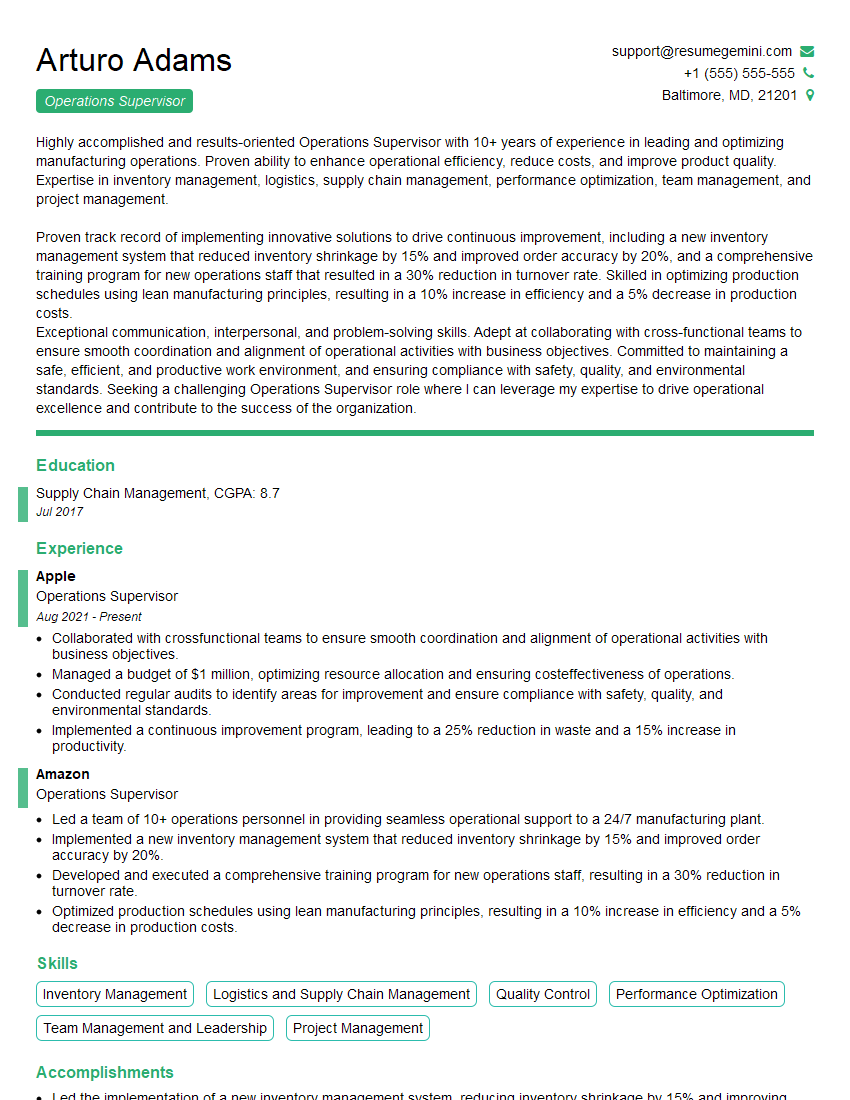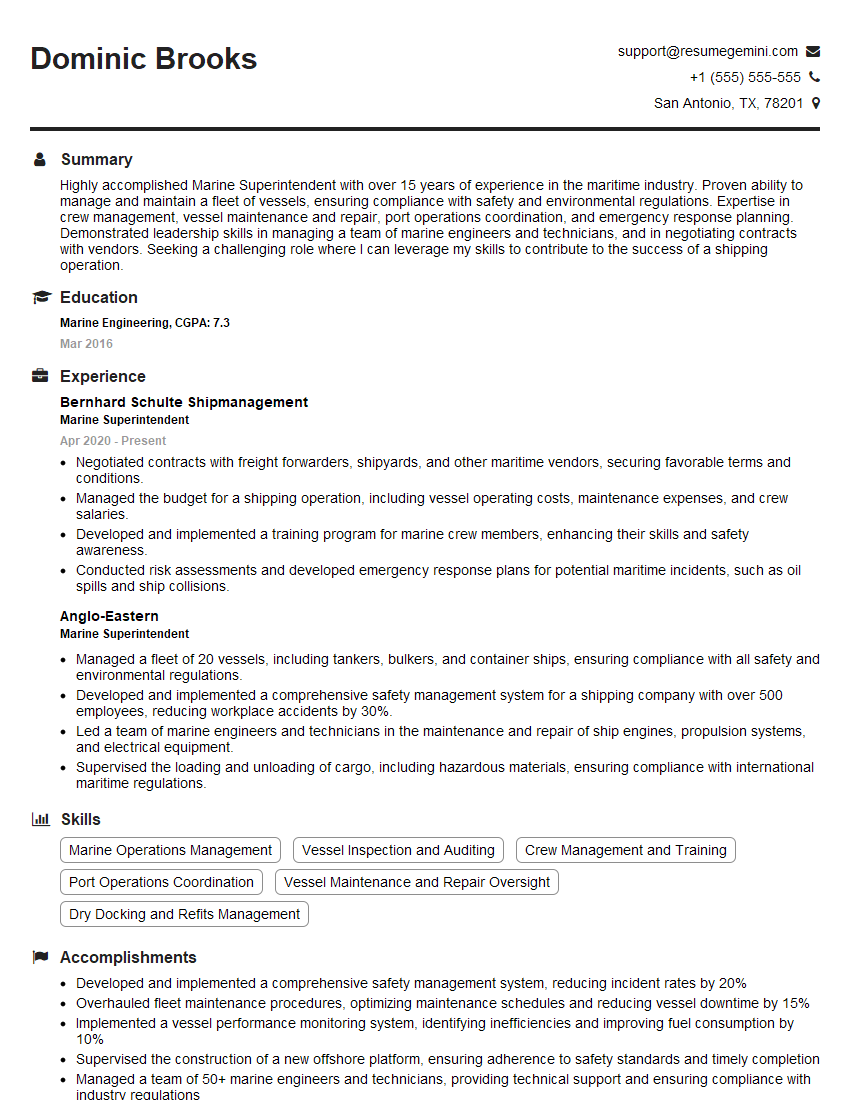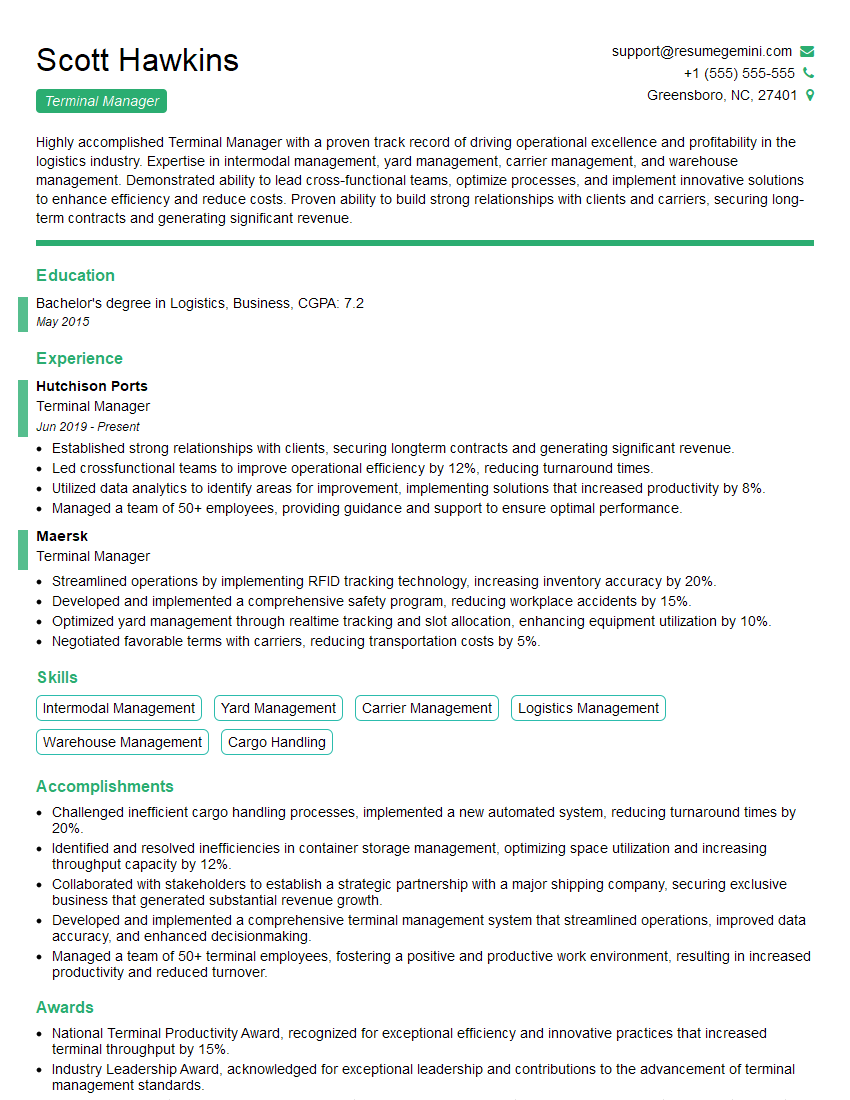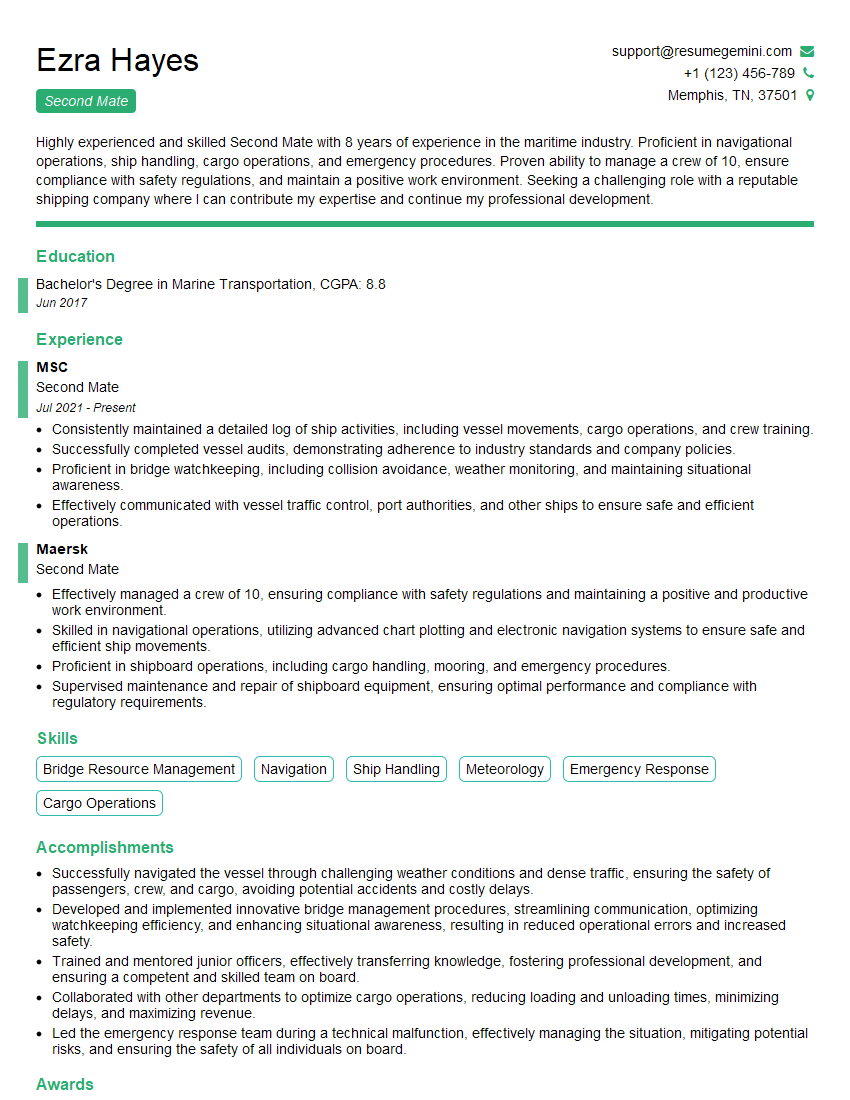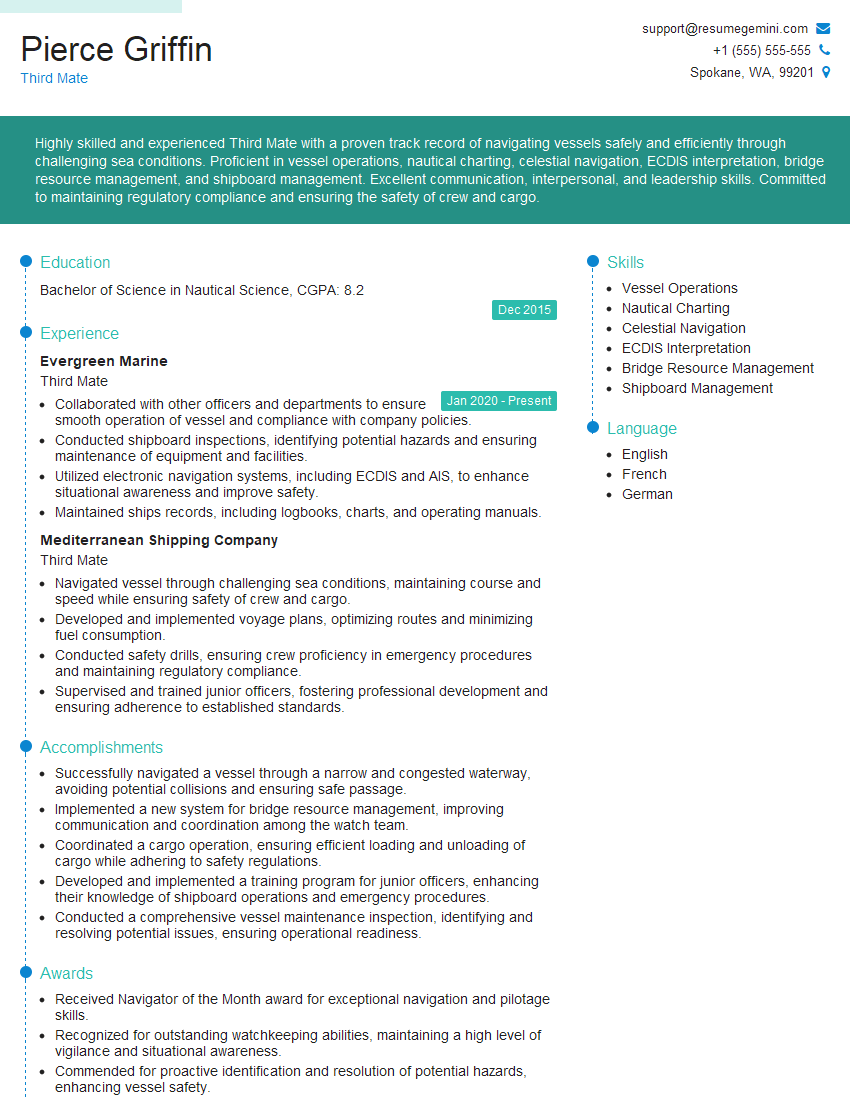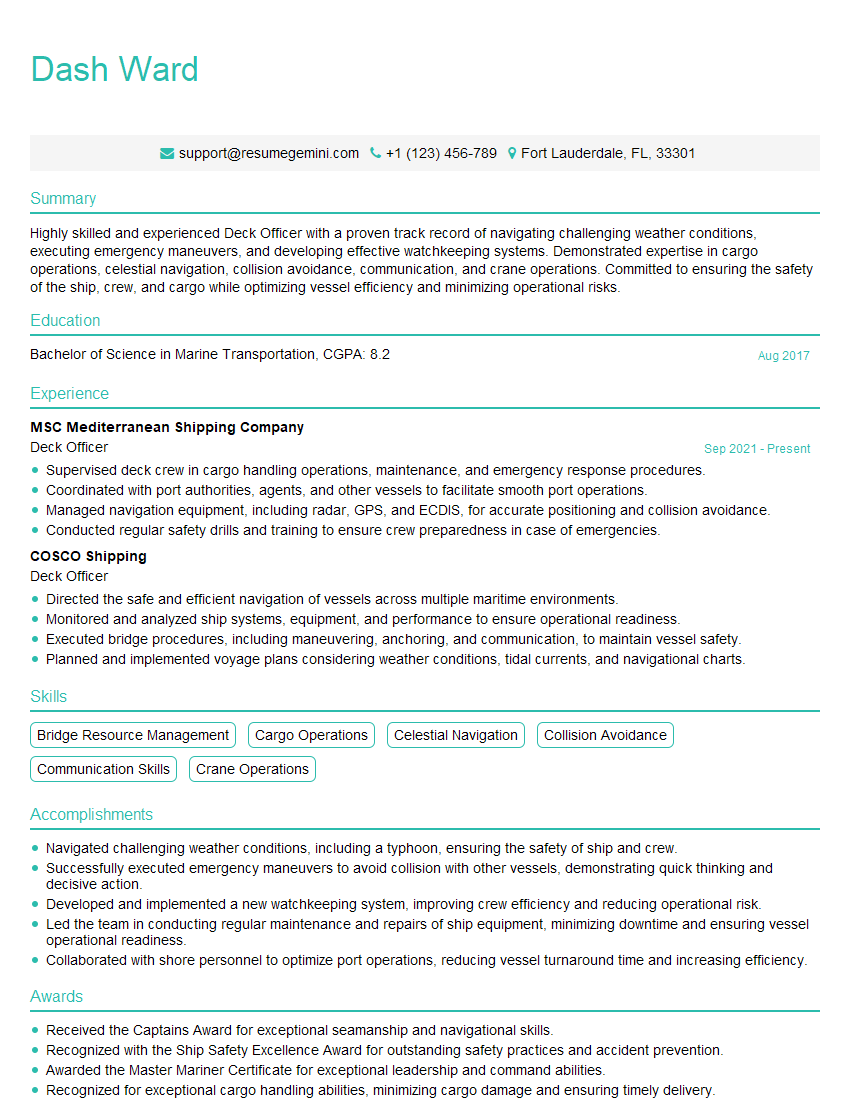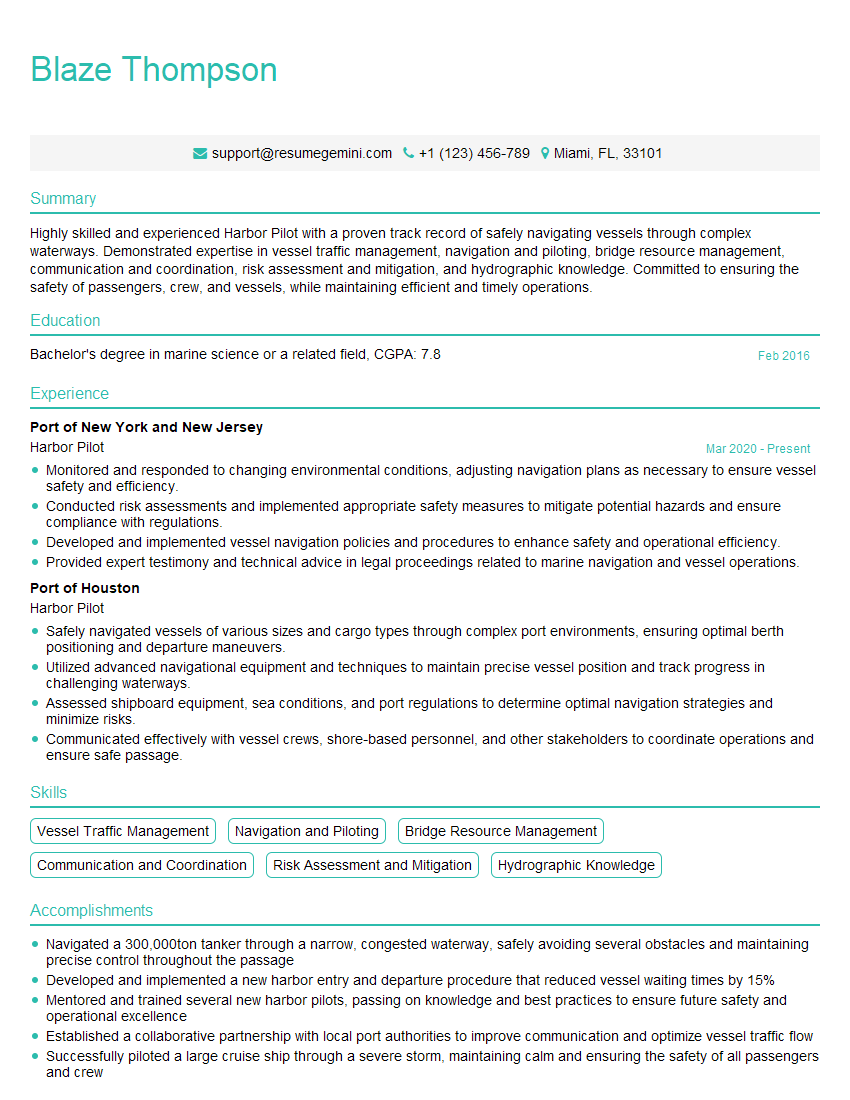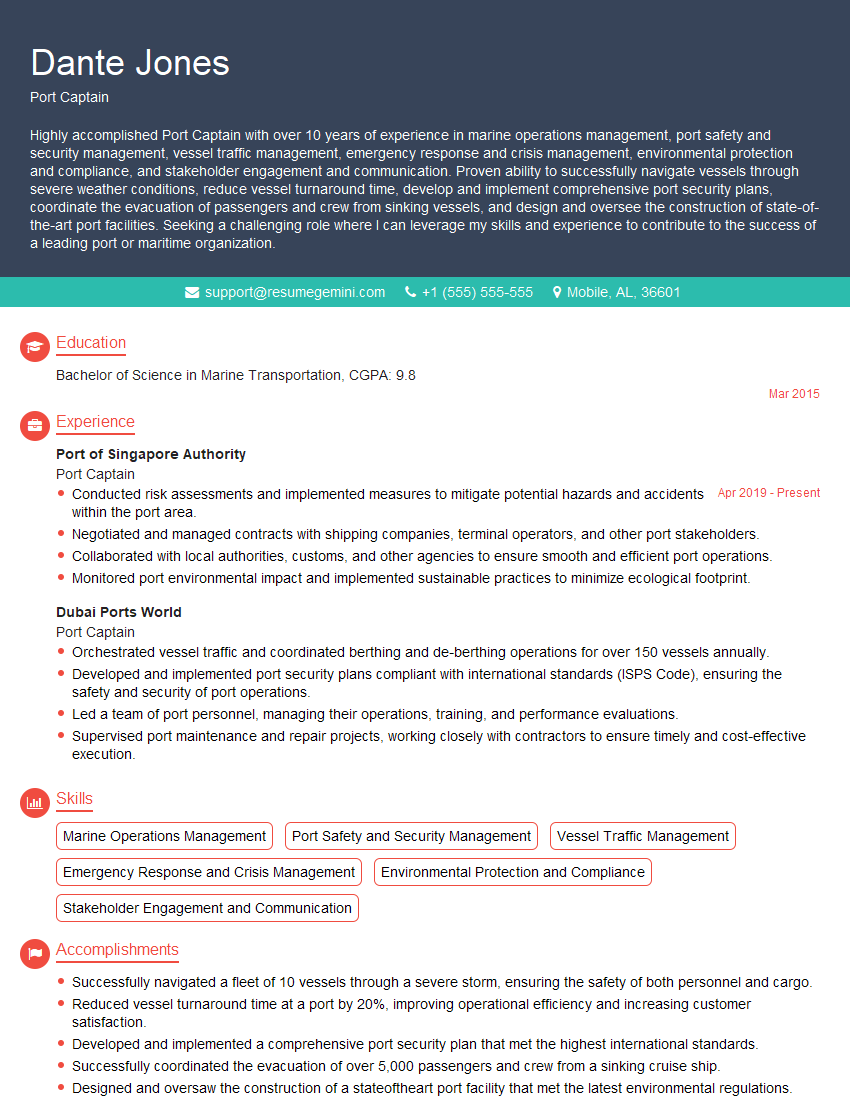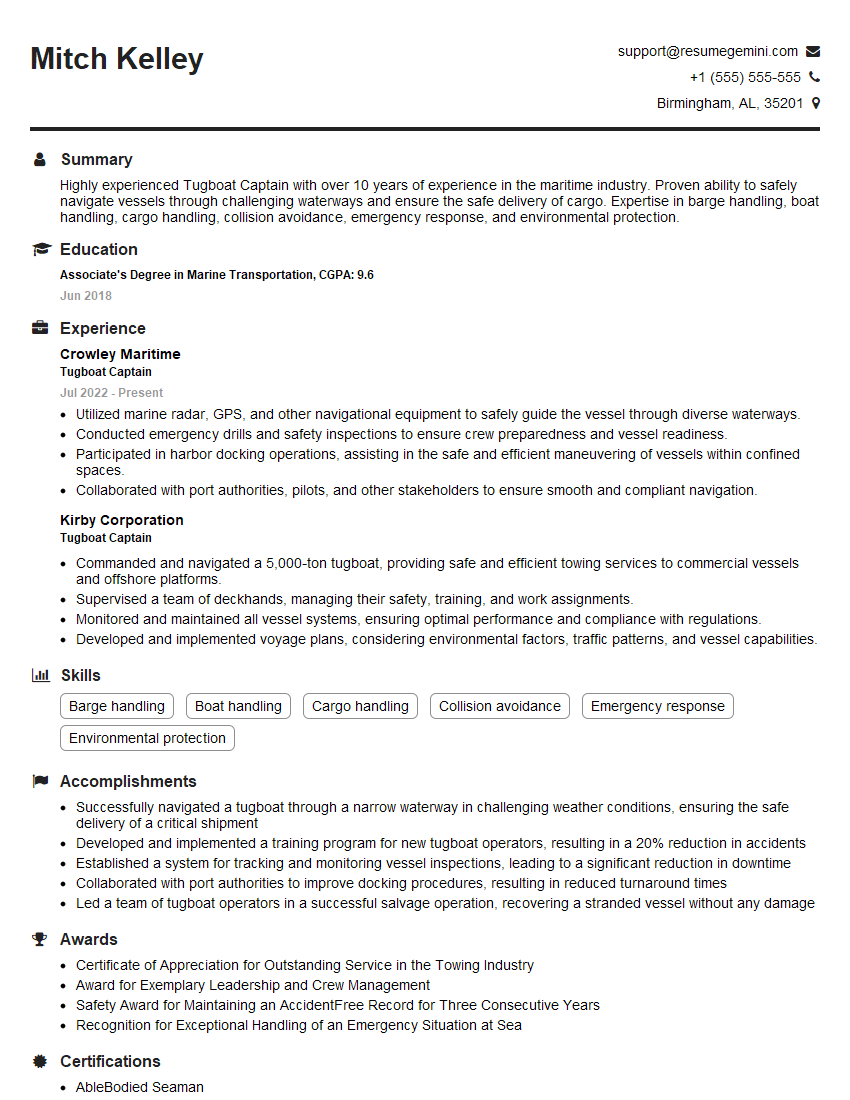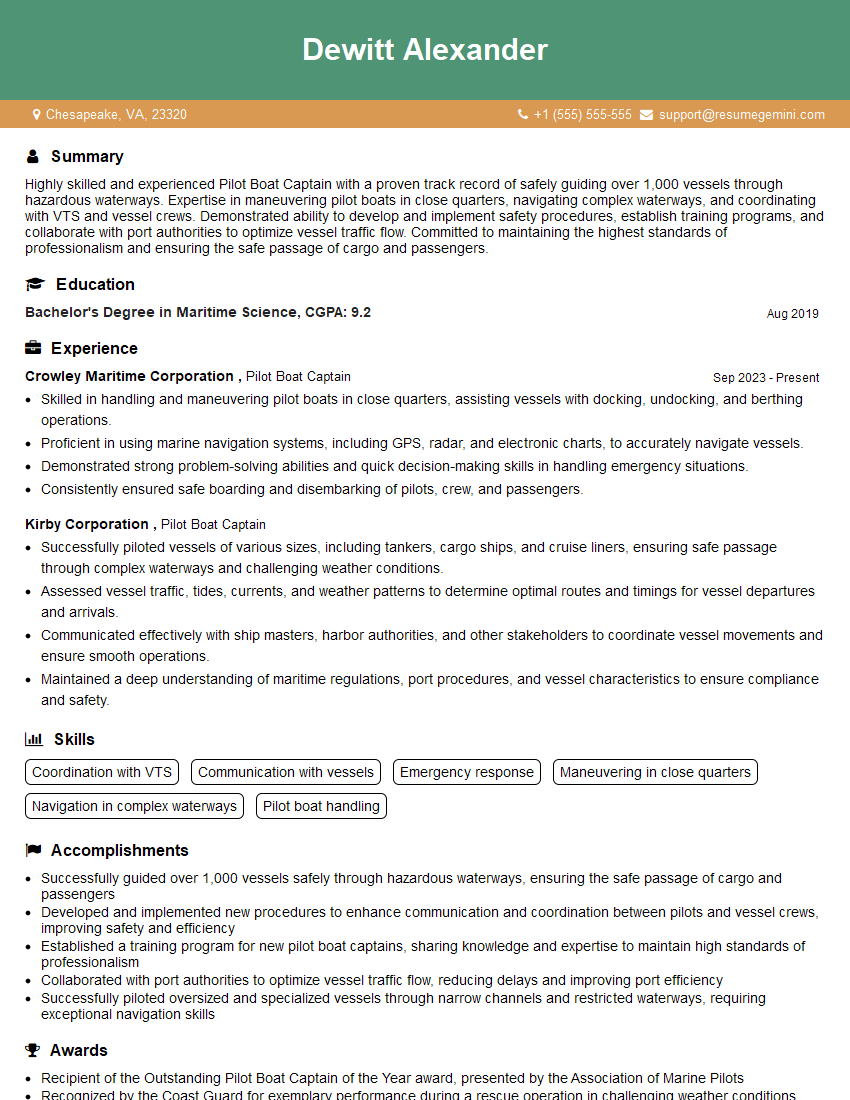The thought of an interview can be nerve-wracking, but the right preparation can make all the difference. Explore this comprehensive guide to Docking and Berthing Operations interview questions and gain the confidence you need to showcase your abilities and secure the role.
Questions Asked in Docking and Berthing Operations Interview
Q 1. Explain the difference between docking and berthing.
While often used interchangeably, docking and berthing have distinct meanings in maritime operations. Docking refers to the process of maneuvering a vessel into a dock or berth, usually involving precise control and often assistance from tugboats. It’s the approach and the final positioning phase. Berthing, on the other hand, is the act of securing the vessel in place once it’s inside the dock or berth. It focuses on the securing procedures—the mooring lines, fenders, and final adjustments for stability.
Think of it like this: docking is like parking your car in a parking spot, while berthing is like setting the parking brake and ensuring your car is secure and won’t roll away.
Q 2. Describe the process of securing a vessel alongside a pier.
Securing a vessel alongside a pier involves a coordinated effort between the bridge, deck crew, and often tugboats. The process generally unfolds as follows:
- Approach: The vessel approaches the pier at a slow, controlled speed, ideally against the current to maintain maneuverability. The captain assesses wind and current conditions for optimal alignment.
- Initial Contact: Using the engines to control momentum, the vessel makes initial contact with the pier, gently nudging against the fenders.
- Mooring Line Deployment: The crew starts deploying mooring lines to secure the vessel to the pier. This typically involves head lines (forward), breast lines (sideways), and stern lines (rear), ensuring the lines are properly led and secured.
- Fender Placement: Fenders are strategically positioned between the vessel and the pier to absorb any impact and prevent damage.
- Final Adjustments: Once the vessel is reasonably secured, the crew may use the engines, winches, and mooring lines for fine-tuning of the vessel’s position and to take up any slack.
- Inspection and Confirmation: The deck crew checks all lines for tightness and security. The bridge ensures the vessel is safely and firmly secured.
Throughout the process, constant communication between the bridge and deck crew is crucial for effective coordination and safety.
Q 3. What are the key safety considerations during docking and berthing operations?
Safety is paramount during docking and berthing operations. Key considerations include:
- Risk Assessment: Thorough assessment of weather conditions (wind, current, tides), vessel characteristics, and pier structure is essential.
- Crew Competence: Trained and experienced personnel are crucial. Each member must understand their roles and responsibilities.
- Clear Communication: Effective communication between the bridge, deck crew, tugboat operators, and shore personnel is vital to prevent accidents. Standardized communication protocols are necessary.
- Equipment Maintenance: Mooring lines, fenders, winches, and other equipment must be well-maintained and regularly inspected to prevent failures.
- Emergency Procedures: Having well-rehearsed emergency plans is important, covering scenarios such as line breaks, equipment malfunction, or sudden changes in weather.
- Personal Protective Equipment (PPE): Appropriate PPE, including safety footwear, gloves, and life jackets, should be worn at all times.
- Environmental Awareness: Awareness and mitigation of environmental impacts such as oil spills is also critical.
Q 4. How do you assess wind and current conditions and their impact on docking?
Accurate assessment of wind and current is critical for safe docking. This involves:
- Wind Speed and Direction: Using anemometers and weather reports, the wind’s strength and direction are determined. Strong winds can significantly affect the vessel’s maneuverability, potentially pushing it off course.
- Current Speed and Direction: Currents can also influence the vessel’s movement, especially in confined waterways. Knowledge of tidal patterns is vital.
- Combined Effect: The combined effect of wind and current needs to be analyzed. A strong current and headwind can make docking much more challenging.
- Impact Assessment: Based on the assessed conditions, the captain determines the best approach and speed, adjusting the plan if necessary. This might involve using tugboats to counteract wind or current.
For example, a strong crosswind might necessitate a slower approach and more precise use of the vessel’s engines and maneuvering thrusters. Accurate prediction and careful planning are essential to mitigate risk.
Q 5. What are the different types of mooring lines and their applications?
Various types of mooring lines are used in docking, each with specific applications:
- Nylon: Strong, relatively elastic, and commonly used for breast lines and head lines. Their elasticity helps absorb shock.
- Polyester: Stronger and less elastic than nylon, often used where high strength and low stretch are needed, like stern lines.
- Polypropylene: Floats on water, useful for lighter-duty applications and in situations where lines need to remain afloat.
- Wire Rope: Very strong but stiff, used for heavy-duty applications or where extreme strength is required, but requires careful handling to avoid damage.
The choice of line depends on factors like vessel size, expected loads, and the specific berthing conditions. It’s crucial to use the right line for the right job to avoid failures.
Q 6. Explain the role of fenders in protecting vessels during docking.
Fenders act as vital buffers between the vessel and the pier, protecting both from damage during docking. They absorb impact energy, reducing the risk of scratches, dents, and other structural damage. Different types of fenders exist, each with different properties:
- Pneumatic Fenders: Filled with air, they offer excellent energy absorption and are relatively lightweight.
- Rubber Fenders: Made of various rubber compounds, offering a range of hardness and energy absorption capabilities.
- Foam Fenders: Offer good energy absorption and are lightweight but may not be suitable for very high-impact situations.
Proper fender placement is critical. Fenders should be positioned at all contact points between the vessel and the pier to ensure even distribution of impact forces.
Q 7. How do you manage communication with the bridge and tugboats during docking?
Effective communication is the cornerstone of safe docking. This involves:
- Designated Channels: Using designated VHF radio channels for communication between the bridge, deck crew, and tugboats helps maintain order and prevents interference.
- Clear Terminology: Using standardized maritime terminology eliminates ambiguity and ensures clear instructions. For example, using terms like “steady,” “slow ahead,” or “stop engines” prevents miscommunication.
- Visual Signals: Hand signals can complement radio communication, especially in noisy environments. Each signal must be understood by everyone involved.
- Regular Check-ins: Regular communication updates ensure everyone is aware of the vessel’s position and progress.
Communication failures can lead to collisions or damage, so clear and concise communication is vital to successful and safe docking procedures.
Q 8. Describe your experience with different types of docking aids (e.g., dolphins, bollards).
Docking aids are crucial for securing a vessel during berthing. My experience encompasses a wide range, including dolphins, bollards, fenders, and mooring winches. Dolphins are essentially large, sturdy piles driven into the seabed, providing a strong point for mooring lines. Bollards, on the other hand, are fixed posts on the quayside or vessel, used to secure mooring lines with a fairlead. Fenders are essential to protect the hull from damage during contact with the dock or another vessel. Mooring winches are used to control the tension and length of mooring lines. I’ve worked with various types and sizes of these aids, from simple bollards on smaller piers to sophisticated hydraulically-operated mooring systems on large container terminals. For instance, during my time working on the port of Rotterdam, I was responsible for the safe and efficient use of a complex system incorporating multiple dolphins, bollards and advanced fendering systems to handle mega-container vessels.
The selection of appropriate docking aids depends heavily on vessel size, type, environmental conditions (such as wind and currents), and the specific infrastructure of the port. I’m experienced in assessing these factors to ensure optimal safety and efficiency during docking procedures.
Q 9. How do you handle unexpected situations during docking, such as equipment failure?
Unexpected situations during docking are part of the job. Equipment failure is a prime example. My approach involves a structured response. First, assess the severity of the failure. Is it a minor issue (e.g., a minor hydraulic leak in a winch) or a major one (e.g., complete winch failure)? If it’s minor, we might continue the operation with modified procedures, increasing vigilance and possibly adjusting our approach to minimize reliance on the affected equipment. For instance, if a winch malfunctions slightly, we might use an auxiliary line or adjust the tension on other lines to compensate.
In the event of major equipment failure, the procedure shifts towards immediate risk mitigation. We immediately communicate with the bridge, shoreside personnel, and any relevant authorities. The emergency plan for the specific scenario is activated, possibly involving alternative mooring techniques or assistance from tugs. A detailed post-incident report is essential, identifying causes of the failure, contributing factors, and potential preventative measures.
I’ve personally dealt with situations where a mooring winch failed mid-berthing. In this instance, we immediately engaged emergency lines and utilized tug assistance to prevent the vessel from drifting. The crew remained calm and followed emergency procedures precisely, a testament to proper training and familiarity with various failure scenarios.
Q 10. What are the limitations of a vessel’s maneuverability during docking?
A vessel’s maneuverability during docking is limited by several factors. These include the vessel’s size and shape (larger vessels have larger turning radii), the vessel’s speed (lower speeds provide more control), the water depth and currents (strong currents can significantly impact control), wind conditions (strong winds can affect the vessel’s heading), and the type of propulsion system (tugs, thrusters, and rudders all contribute differently to maneuverability). Furthermore, the presence of surrounding vessels and obstacles further restricts the freedom of movement.
Imagine trying to park a large truck compared to a small car in a tight space; the same principles apply. Large vessels require significantly more space and time to complete docking maneuvers. I always factor in these limitations when planning and executing a docking operation, allowing for a safety margin to account for unexpected events. Proper knowledge of the vessel’s specifications, hydrodynamics and response characteristics to different control inputs is crucial for navigating these limitations safely and efficiently.
Q 11. Explain the concept of a safe working load for mooring lines.
The safe working load (SWL) for a mooring line is the maximum load that the line can safely withstand without breaking or suffering permanent damage. This is crucial for safety, as exceeding the SWL can lead to line failure, causing significant damage to the vessel, the quay, and potentially injuring personnel. The SWL is determined by the line’s material, diameter, and construction, and is usually specified by the manufacturer. It’s not just about the breaking strength; factors like fatigue and wear also need to be considered. Lines degrade over time, especially in harsh marine environments.
For example, a mooring line with a SWL of 10 tons shouldn’t be subjected to loads exceeding this limit. Regularly inspecting lines for wear and tear and ensuring that the SWL is never exceeded is paramount to safe operations. Proper load distribution is also important. This includes avoiding sharp bends that weaken the line and evenly distributing the load amongst multiple lines.
Q 12. How do you ensure the safe handling of mooring lines?
Safe handling of mooring lines involves a multi-faceted approach, starting with pre-docking preparations and continuing throughout the operation and post-docking phases. Before commencing, inspect all lines for damage, ensuring they meet the SWL requirements for the specific operation. Use appropriate personal protective equipment (PPE) including gloves to protect hands from abrasion and chafing. When handling lines, always ensure they are correctly coiled and stored, to avoid snags or tangles.
During the docking procedure, the lines must be handled smoothly and carefully, avoiding sudden jerks or excessive strain. Lines should be properly secured to bollards and other mooring points, ensuring that there are no sharp bends or kinks. Regular inspections are needed to monitor tension and for any signs of wear or damage. Post-docking procedures include correctly securing the lines, ensuring adequate slack, and performing a final inspection to prevent any issues caused by shifting weight or external forces during the vessel’s stay.
Proper training and communication are critical to safe handling. Teamwork between the deck crew and the shoreside personnel is crucial, so everyone is aware of the lines’ location and tension.
Q 13. What are the procedures for handling emergency situations during docking?
Emergency situations during docking require a calm and organized response. Procedures are established for various scenarios, ranging from equipment failure to sudden severe weather changes or collisions. A clear chain of command and communication protocols are paramount. Immediate actions involve informing the bridge, shoreside personnel, and relevant authorities (e.g., port control, coastguard). Emergency equipment, such as tugs, extra mooring lines and additional personnel, might need to be deployed quickly.
The specific procedures depend on the nature of the emergency. For instance, a fire onboard would require activation of the fire-fighting systems and evacuation procedures. A sudden onset of heavy weather might necessitate activating the storm mooring plan, involving additional lines and tug assistance. Post-incident investigations are essential to determine the root causes and implement any necessary corrective actions.
Regular drills are conducted to ensure personnel are familiar with emergency procedures, including vessel-specific and port-specific emergency response plans. This ensures effective responses should an unexpected event occur.
Q 14. How do you calculate the required number of mooring lines for a specific vessel?
Calculating the required number of mooring lines involves several factors. Vessel size and type are key considerations. Larger vessels naturally require more lines to ensure adequate security. The environmental conditions (wind, current, wave height) also play a crucial role, with harsher conditions necessitating more lines. The type of berth and its infrastructure (e.g., presence of dolphins, bollards) also influence the number of lines needed. Furthermore, the type of cargo influences the requirement; a vessel with a heavy cargo might require more lines than one with a lighter cargo.
There’s no single formula; it’s more of an expert judgment based on experience and guidelines. Port authorities often have standards and recommendations for various vessel types and berthing conditions. Safety margins are always built in. A higher number of lines than the minimum calculated is often preferred, providing redundancy in case of a line failure. My experience involves utilizing established guidelines and personal judgement for each specific scenario, taking into account all relevant factors to ensure safe and secure mooring arrangements.
Q 15. What are the various methods for transferring personnel between the vessel and the shore?
Personnel transfer between vessel and shore employs various methods, chosen based on factors like vessel size, port infrastructure, weather conditions, and safety regulations. The most common methods include:
- Gangway: A portable or fixed walkway, often with railings and safety nets, providing a safe passage for personnel. This is ideal for smaller vessels and calmer conditions. Imagine it like a bridge connecting the ship and the dock.
- Boat Transfer: Smaller boats or launches ferry personnel between the vessel and the shore, particularly useful for larger vessels or when a gangway isn’t feasible due to distance or sea state. Think of it as a water taxi service.
- Helicopter Transfer: For offshore platforms or vessels far from shore, helicopters offer a rapid and efficient transfer method, especially in emergencies. It’s like a quick, aerial taxi.
- Pilot Ladder: A specialized ladder used for transferring pilots or other personnel to and from vessels, typically used when a gangway isn’t available. Its design ensures safe ascent and descent even in rough seas. This is a more specialized method requiring trained personnel.
- Rope Access Techniques: In some specialized situations, such as inspections of very large vessels, rope access methods might be employed for safe personnel transfer.
The selection of the appropriate method requires a careful risk assessment, taking into account all potential hazards and ensuring compliance with safety regulations.
Career Expert Tips:
- Ace those interviews! Prepare effectively by reviewing the Top 50 Most Common Interview Questions on ResumeGemini.
- Navigate your job search with confidence! Explore a wide range of Career Tips on ResumeGemini. Learn about common challenges and recommendations to overcome them.
- Craft the perfect resume! Master the Art of Resume Writing with ResumeGemini’s guide. Showcase your unique qualifications and achievements effectively.
- Don’t miss out on holiday savings! Build your dream resume with ResumeGemini’s ATS optimized templates.
Q 16. Describe your experience with different types of vessels and their specific docking requirements.
My experience encompasses a wide range of vessels, from small fishing trawlers to large container ships and LNG carriers. Each vessel type presents unique docking challenges:
- Container Ships: These require precise maneuvering due to their sheer size and the need to align perfectly with the quayside for efficient cargo handling. Consideration of wind and currents is critical, as even a slight misalignment can result in significant delays and potential damage.
- LNG Carriers: These vessels demand meticulous attention to safety due to the hazardous nature of their cargo. Specialized mooring equipment and procedures are necessary, along with rigorous pre-docking planning to mitigate any risk of leaks or explosions.
- Cruise Ships: Large passenger vessels often require the assistance of tugboats for precise maneuvering in confined spaces. Passenger safety is paramount, so docking procedures are planned and executed with meticulous care to avoid any risk to the passengers or the ship.
- Small Craft: While seemingly simpler, smaller vessels can still present challenges in adverse weather conditions or in crowded harbors. Skillful maneuvering and careful judgment are crucial to avoid collisions.
My experience allows me to adapt my approach to each vessel’s specific characteristics and limitations, ensuring safe and efficient docking in diverse environments. I always prioritize safety and compliance with all applicable regulations.
Q 17. How do you interpret navigational charts and aids to navigation during docking?
Navigational charts and aids to navigation are indispensable during docking. I interpret them by:
- Chart Study: Thoroughly reviewing the chart prior to docking, identifying water depths, obstructions, and any restricted areas. I look for critical details such as the location of buoys, beacons, and any underwater hazards.
- Aid to Navigation Interpretation: Understanding the meaning and significance of various navigational aids – buoys (lateral, cardinal, isolated danger), beacons, lights, and range markers – to ascertain vessel position and safe passage.
- Depth Soundings: Using the echo sounder to constantly monitor water depth to avoid grounding, especially in areas with shallow water or uneven seabed.
- Tidal information: Checking the predicted tidal heights and currents to account for their influence on the vessel’s movement and trajectory.
By combining chart information with real-time sensor data and visual observations, I can make informed decisions about the most efficient and safe docking approach. It’s like using a detailed map and compass, combined with a GPS device, for precise navigation.
Q 18. What is your understanding of tidal currents and their effect on docking operations?
Tidal currents significantly impact docking operations. Understanding their strength and direction is crucial for successful berthing. A strong current can push the vessel off course, making it difficult to control and potentially causing collisions. The speed and direction of the current can affect the amount of engine power required to maneuver the vessel accurately.
I use tidal predictions, obtained from harbor authorities or specialized software, to anticipate current strength and direction. I adjust my approach and maneuver accordingly, using the current to my advantage whenever possible or compensating for it using engine power and tug assistance as needed. For example, if a strong current is pushing the vessel away from the berth, I may require additional tugboat assistance, or a different approach altogether, to compensate.
Q 19. How do you use wind speed and direction to plan docking maneuvers?
Wind speed and direction are key factors in planning docking maneuvers. Strong winds can significantly affect a vessel’s handling, making it more difficult to control its movement. The effects of wind can be particularly pronounced for larger vessels with a high windage area.
I utilize weather forecasts and real-time wind data to predict the wind’s influence. If strong winds are anticipated, I may need to request additional tugboat assistance for precise positioning, or delay the docking operation until conditions improve. I also adjust the vessel’s approach and speed to minimize the effect of wind on the vessel’s trajectory. For example, I might approach the berth at a slight angle to counteract the wind’s effect. It’s a bit like sailing a boat – you need to account for the wind to reach your destination safely and efficiently.
Q 20. Explain the importance of pre-docking planning and risk assessment.
Pre-docking planning and risk assessment are fundamental to safe and efficient docking operations. They involve:
- Chart Review: Detailed examination of navigational charts to identify potential hazards and optimal berthing locations.
- Weather Forecasting: Assessing wind speed, direction, currents, and visibility to plan accordingly.
- Vessel Information: Gathering data on the vessel’s dimensions, draft, and maneuverability.
- Port Information: Obtaining information on berth characteristics, available aids, and potential constraints.
- Communication Plan: Establishing clear communication channels between the vessel’s crew, harbor pilots, tugboats, and shoreside personnel.
- Risk Assessment: Identifying potential hazards, such as collisions, grounding, and equipment failure, and developing mitigation strategies.
A comprehensive risk assessment helps anticipate and avoid potential problems, minimizing the likelihood of incidents and ensuring the safety of personnel and equipment. It’s like creating a detailed roadmap before embarking on a journey – the more you plan, the smoother the journey will be.
Q 21. What are the environmental considerations during docking and berthing?
Environmental considerations are paramount during docking and berthing. They include:
- Water Pollution: Preventing oil spills or other forms of pollution through careful handling of ballast water and waste disposal. This requires stringent adherence to international maritime regulations and best practices.
- Noise Pollution: Minimizing noise emissions from vessel operations to reduce the impact on marine life and nearby communities. Employing quieter operational techniques whenever possible can make a significant difference.
- Air Quality: Reducing emissions from vessel engines to improve air quality. This often involves using cleaner fuels or optimizing engine operations.
- Marine Life Protection: Avoiding damage to marine habitats during mooring operations and ensuring the safety of marine life. This involves careful navigation and the avoidance of sensitive ecological areas.
- Waste Management: Proper disposal of waste generated during berthing operations to minimize its impact on the marine environment. This involves the use of designated waste reception facilities and adherence to strict environmental guidelines.
Responsible docking and berthing practices minimize the environmental footprint of maritime operations, safeguarding the marine ecosystem for future generations. It is our duty as maritime professionals to minimize our impact on the environment.
Q 22. How do you communicate effectively with other vessels and harbor authorities?
Effective communication is paramount in docking and berthing. It’s a team effort involving the vessel’s crew, harbor pilots, tugboat operators, and port authorities. We primarily use VHF radio, adhering to standard maritime communication protocols. This involves clear, concise language, using established terminology to avoid ambiguity. For instance, I would use phrases like ‘Requesting permission to proceed to berth 3,’ or ‘Vessel underway, approaching berth, requesting assistance.’ Beyond VHF, we also employ pre-arranged plans, sometimes using visual signals like hand signals from pilot boats during tight maneuvers, and post-operation briefings to discuss any improvements for future operations.
Furthermore, maintaining open communication channels with harbor authorities is critical for updates on weather conditions, potential delays, or any unforeseen issues within the harbor. Clear communication ensures safety and prevents incidents.
Q 23. Describe your experience with using navigational equipment during docking.
My experience with navigational equipment during docking spans many years and various vessel types. I’m proficient in using GPS, radar, Automatic Identification System (AIS), and Electronic Chart Display and Information System (ECDIS). The ECDIS is particularly crucial, providing real-time positioning, depth information, and detailed charts. It allows for precise planning of the docking maneuver, considering factors such as vessel draft, tidal currents, and wind. Radar helps monitor surrounding vessels and environmental conditions like fog. AIS enhances situational awareness by displaying the position and movement of nearby ships.
For example, during a recent docking operation in challenging conditions, the ECDIS’s depth soundings allowed us to avoid a previously uncharted shoal, preventing a potential grounding. We also utilized the radar to maintain a safe distance from a large container ship entering the harbor simultaneously.
Q 24. Explain the process of releasing a vessel from its moorings.
Releasing a vessel from its moorings is a carefully orchestrated process that requires precise coordination and attention to detail. The steps typically involve:
- Checking lines and securing equipment: Inspecting all mooring lines and ensuring all associated equipment (e.g., winches, bollards) are in good working order and ready for release.
- Communicating with tugboats (if applicable): Coordinating with tugboats to ensure they are in position and ready to assist with the departure maneuver.
- Systematic line release: Lines are released systematically, usually starting with the less critical lines and then progressing to the main lines, ensuring the vessel maintains a controlled movement.
- Engine operation: Careful control of the vessel’s engines is crucial to avoid sudden movements during the line-releasing procedure, using slow and controlled speed.
- Monitoring vessel movements: Continuous monitoring of the vessel’s position and movement to ensure a smooth departure.
- Clearance confirmation: Confirming that there is sufficient clearance from other vessels and obstructions before departing the berth.
Safety is paramount throughout this process. Each step is meticulously executed to prevent accidents or damage.
Q 25. What are the potential hazards associated with improper docking procedures?
Improper docking procedures can lead to a range of serious hazards, including:
- Collision with other vessels or structures: Poor judgment and inadequate communication can result in collisions that cause significant damage and potential injury.
- Grounding: Failure to account for factors like depth, tides, and currents can result in the vessel running aground, causing damage to the hull and potentially the environment.
- Damage to vessel or harbor infrastructure: Incorrect handling of lines and inadequate control of the vessel’s movement can cause damage to the vessel itself or to the harbor’s infrastructure (docks, fenders, etc.).
- Injuries to personnel: Lack of safety protocols and inadequate coordination can lead to injuries among crew members, dockworkers, and other personnel.
- Environmental damage: Accidents involving fuel spills or other pollutants can significantly harm the marine environment.
Prevention involves rigorous training, detailed planning, adherence to safety procedures, and clear communication among all involved parties.
Q 26. How do you handle conflicts with other vessels or harbor personnel during docking?
Conflicts during docking operations are sometimes unavoidable. My approach focuses on professional and respectful communication. I begin by actively listening to the other party’s perspective. Clarifying misunderstandings and finding common ground are crucial. If the conflict involves a difference in interpretation of regulations or procedures, I would refer to the relevant regulations or seek guidance from harbor authorities to resolve the issue fairly. If the situation escalates, I’d involve a senior officer or harbor master to mediate.
For example, in one instance, a disagreement arose with another vessel’s captain about berth priority. By calmly presenting our planned arrival time and referencing port regulations, we were able to reach a compromise that avoided delays and maintained safety.
Q 27. What are your strategies for managing stress and pressure during critical docking operations?
Managing stress and pressure during critical docking operations requires a structured approach. This includes:
- Thorough pre-planning: Detailed planning, including familiarizing myself with the berth, checking weather conditions, and anticipating potential challenges, reduces uncertainty and stress.
- Effective communication: Maintaining open communication with all involved parties keeps everyone informed and reduces the likelihood of unexpected issues.
- Teamwork and delegation: Efficiently delegating tasks to competent crew members reduces my workload and ensures all critical functions are handled.
- Mental preparation: I utilize techniques such as deep breathing and visualization to maintain focus and calmness under pressure.
- Post-operation debriefing: Reviewing the operation afterwards helps identify areas for improvement and reduces future stress by promoting continuous learning.
Remembering that a calm, collected approach is essential for effective decision-making in stressful situations is key.
Q 28. Describe a situation where you had to make a quick decision during a docking operation.
During a night docking operation in a narrow channel with strong crosswinds, a sudden surge in the wind pushed our vessel significantly off course. I had to quickly assess the situation, deciding to immediately employ the tugboat’s assistance to counter the wind’s effect and prevent a potential collision with a nearby pier. Simultaneously, I communicated the change in plan to the harbor authorities and the tugboat captain using VHF radio. By acting decisively and effectively communicating the situation, we managed to avert a potentially serious accident and safely complete the docking maneuver.
Key Topics to Learn for Docking and Berthing Operations Interview
- Vessel Handling: Understanding principles of ship maneuvering, including effects of wind, current, and tide on vessel response. Practical application: Analyzing a specific scenario and explaining the optimal maneuvering techniques to ensure safe docking.
- Mooring Systems: Knowledge of various mooring equipment (lines, fenders, anchors), their proper use and limitations. Practical application: Describing the selection process for appropriate mooring equipment based on environmental conditions and vessel characteristics.
- Safety Procedures and Regulations: Familiarity with international maritime regulations (SOLAS, MARPOL, etc.) and company-specific safety protocols for docking and berthing. Practical application: Explaining the safety measures to be taken during a challenging docking operation in adverse weather.
- Communication and Teamwork: Effective communication with bridge crew, harbor pilots, and tugboat operators. Practical application: Describing your approach to coordinating a complex berthing operation involving multiple parties.
- Risk Assessment and Mitigation: Identifying potential hazards during docking and berthing and implementing strategies to minimize risks. Practical application: Providing a detailed risk assessment for a specific docking scenario and explaining your mitigation plan.
- Emergency Procedures: Knowledge of emergency response procedures in case of equipment failure, unexpected weather changes, or other unforeseen circumstances. Practical application: Outlining your actions in response to a specific emergency scenario during a berthing operation.
- Port Operations and Infrastructure: Understanding port layout, navigational aids, and limitations of port infrastructure. Practical application: Explaining how your understanding of port limitations informs your decision-making during berthing.
Next Steps
Mastering Docking and Berthing Operations is crucial for career advancement in the maritime industry, opening doors to higher-paying roles and increased responsibilities. A well-crafted resume is your key to unlocking these opportunities. An ATS-friendly resume ensures your qualifications are effectively communicated to potential employers. We recommend using ResumeGemini to build a professional and impactful resume that highlights your skills and experience. ResumeGemini provides examples of resumes tailored to Docking and Berthing Operations to help you create a standout application.
Explore more articles
Users Rating of Our Blogs
Share Your Experience
We value your feedback! Please rate our content and share your thoughts (optional).
What Readers Say About Our Blog
Hi, I’m Jay, we have a few potential clients that are interested in your services, thought you might be a good fit. I’d love to talk about the details, when do you have time to talk?
Best,
Jay
Founder | CEO
